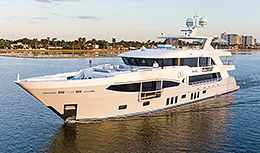- Alaskan Yachts
- Azimut Yachts
- Back Cove Yachts
- Beneteau Yachts
- Benetti Superyachts
- Bertram Yachts
- Boston Whaler
- Broward Yachts
- Buddy Davis Sportfish
- Burger Yachts
- Cabo Yachts
- Catamarans
- Carver Motoryachts
- Center Console
- Chris-Craft Yachts
- Cruisers Yachts
- DeFever Trawlers
- Dufour Sailboats
- Fairline Yachts
- Feadship Yachts
- Ferretti Yachts
- Formula Yachts
- Fountaine Pajot Cats
- Grady-White
- Grand Banks Trawlers
- Hargrave Yachts
- Hatteras Yachts
- Hinckley Picnic Boats
- Horizon Yachts
- Hydra-Sports
- Intrepid Boats
- Jarrett Bay Sportfish
- Jeanneau Yachts
- Kadey-Krogen Trawlers
- Lazzara Yachts
- Lekker Boats
- Luhrs Sportfish
- Marlow Yachts
- Maritimo Yachts
- Marquis Yachts
- McKinna Motoryachts
- Meridian Yachts
- Midnight Express
- MJM Yachts
- Mochi Craft
- Neptunus Motoryachts
- Nordhavn Trawlers
- Nordic Tugs
- Numarine Yachts
- Ocean Alexander Yachts
- Offshore Yachts
- Outer Reef
- Oyster Sailing Yachts
- Pacific Mariner Yachts
- Palmer Johnson Yachts
The Titanic from a Submersible: Witness to History
There’s nothing like diving more than two miles underwater to witness the Titanic for yourself.
This article was written by Kim Frank for Frank Magazine Issue 05, published in March 2023. Photography courtesy of Oceangate, David Concannon, and Kim Frank.

The Titanic.
I’ll place her name on its own line, such is her weight. What fuels the enduring intrigue? When James Cameron rekindled our collective fascination with the ship, he gave us historically influenced characters to root for, and revealed a parallel theme—exploration of the wreck itself. It is a potent combination to imagine that one of us could simultaneously float on the same open ocean coordinates in the North Atlantic, conjuring our inner Unsinkable Molly Brown, and descend 12,460 feet in a submersible to witness the Titanic.
For the first 73 years, Titanic enthusiasts (and there are millions worldwide) had only speculation, passed-down artifacts, swapped stories first-hand, and later from dog-eared pages of Walter Lord’s A Night to Remember, to satiate the appetite. But, in 1985, when the joint French-American expedition led by Jean-Louis Michel and Robert Ballard discovered the wreck site, a race to explore ensued.

At the time, only four submersibles on earth had the technical ability to carry humans to this depth. All of them were spheres made of titanium or steel and could fit three people—picture a cannon ball with origami-folded occupants. Two Russian Mirs, the French Nautile, and the American Alvin. Deep-sea exploration was severely limited by size, expertise, finances, and connections. For decades, only a chosen few explorers were granted a dive, fewer than have ventured to space. Among them was David Concannon, an explorer and lawyer, who (at the ripe age of 34) won the Haver vs RMS Titanic, Inc. lawsuit to restore access to the Titanic for exploration and filming. He wrote this account of his first dive in 2000:
“As we glide aft on the starboard side of the boat deck past the officers’ quarters, we notice that the ceiling and wall of Captain Smith’s stateroom have almost completely collapsed. This is significant because the wall was here just 10 months ago. In 1999, the wall was peeled away and hanging precariously. Now, a large section of the wall has disappeared, and I can stare directly down into Captain Smith’s bathtub.”

In 2005, Concannon led the last expedition using the Mir submersibles. After that, opportunities to explore the wreck dwindled; the Mirs and Nautile were retired and Alvin underwent a lengthy refit. Eventually, one submersible was commissioned by a private individual for his own use. All dreams to explore Titanic by the rest of us were dashed.
Until…
Once upon a time, a little boy dreamt of being an astronaut, then Captain Kirk of the Starship Enterprise, and from there Han Solo, commanding the Millennium Falcon. That same boy took apart his stuffed bear to study the mechanism that made the animal talk. When this boy became a young man, he built his own fiberglass plane from a 600-page manual and a kit, starting in his mother’s garage.

Decades later, he envisioned a new kind of crewed five-person submersible in a unique cylinder shape, utilizing carbon fiber, a material not yet used for deep ocean exploration. A submersible that would defy convention and have the potential to democratize ocean exploration.
Meet Stockton Rush, founder of OceanGate Expeditions, creator of Titan, a submersible capable of successfully diving to the Titanic with crews that include scientists and ordinary citizens, called “Mission Specialists”.
With an unusually thick shock of blondish-gray hair, chiselled features, and piercing blue eyes, Stockton’s dynamic energy and witty, mad-scientist personality is hardly concealed. Stockton seems more like wild genius seeping out from his foundation of California laid-back cool, with a veneer of Seattle-style suitability tossed in for the sake of business meetings. As I interview Stockton, we are sitting on those open ocean coordinates, two and a half miles above the fabled ship.

“What makes Titan different than anything ever built?” I ask.
“Essentially, the difference is the carbon fiber and titanium pressure vessel. Carbon fiber is used successfully in yachts and aviation, but it has not been used in crewed submersibles.”
According to Stockton, this stall in innovation is caused by fear of using new materials. Given how small the submersible manufacturing space is, and how few new subs are made, there is little motivation to stretch the envelope.
In Stockton’s words: “I am so far out of the box, that if you are in the box, outside the box looks like a bunch of maniacs. Out-of-the-box maniacs smashing the box.”

OceanGate Expeditions’ team has made 13 successful dives to the Titanic in Titan over the past two years. They are successfully disrupting the nascent deep-sea submersible space. “One of the criticisms we still get is: ‘the sub isn’t certified,’” says Stockton. “But how can you create something new and get certified through a process that is designed for something wholly different? I think it was MacArthur who said, ‘You are remembered for the rules you break.’ We try to break the rules intelligently and intentionally. A lot has changed in the last fifty years, such as rules for using metal for manned subs. We now know a lot about composites and how to manufacture and test them, making certain they work.”

Request a Copy
Special Thanks to Our Sponsors








